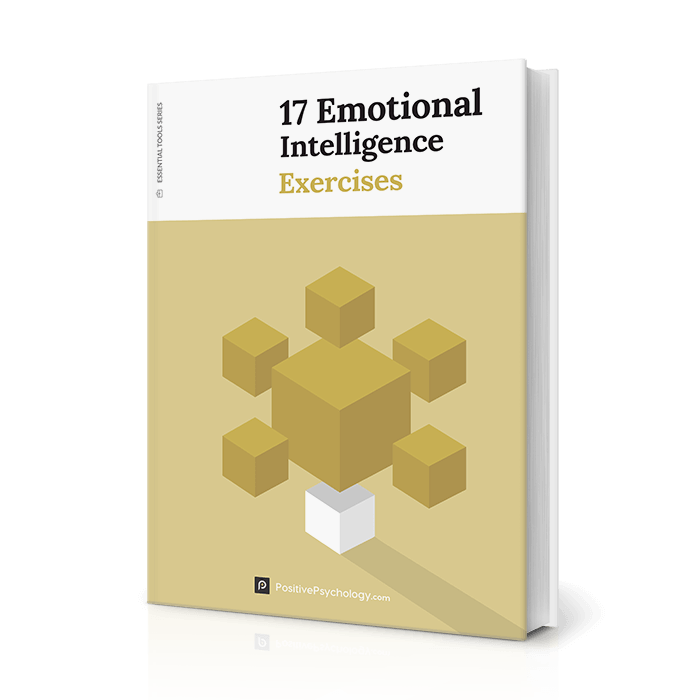Challenging Negative Automatic Thoughts: 5 Worksheets (+PDF)
 Automatic thoughts are images, words, or other kinds of mental activity that pop into your head in response to a trigger.
Automatic thoughts are images, words, or other kinds of mental activity that pop into your head in response to a trigger.
These thoughts can seem mundane or unimportant, but they can, in fact, be extremely impactful. The types of automatic thoughts a person has can affect their health outcomes as well as their overall quality of life.
This article will cover what automatic thinking is and how it affects people’s lives, what automatic thoughts look like, and how to break the cycle of negativity with positive thoughts.
Before you continue, we thought you might like to download our three Emotional Intelligence Exercises for free. These science-based exercises will not only enhance your ability to understand and work with your emotions but will also give you the tools to foster the emotional intelligence of your clients, students, or employees.
This Article Contains:
- What Is Automatic Thinking?
- Our Cognitive Bias: Construction of the Self-Concept
- Aaron Beck’s Cognitive Triad
- 50+ Examples of Positive and Negative Automatic Thoughts
- Cognitive Restructuring of Core Beliefs and Automatic Thoughts
- 5 CBT Worksheets For Challenging Negative Self-Talk and Automatic Thoughts
- A Take-Home Message
- References
What Is Automatic Thinking?
Automatic thinking refers to automatic thoughts that stem from beliefs people hold about themselves and the world (Soflau & David, 2017). Automatic thoughts can be considered “surface-level, non-volitional, stream-of-consciousness cognitions” that “can appear in the form of descriptions, inferences, or situation-specific evaluations” (Soflau & David, 2017).
As the name indicates, these automatic thoughts cannot be controlled by people directly, since they are reflexive reactions based on the beliefs people hold about themselves and the world. However, people can indirectly control these thoughts by challenging the beliefs that lead to them.
Relevant research into automatic thinking began with Aaron Beck’s research into how negative automatic thoughts affect the development of depression (Beck et al., 1979). Before long, researchers decided that positive automatic thoughts were also important to study, and particularly the relationship between both positive and negative automatic thoughts (Ingram & Wisnicki, 1988).
Studies have indicated that there are a variety of consequences of being disposed toward negative automatic thoughts rather than positive automatic thoughts.
In a study by Riley et al., their focus was on the relationship between automatic thoughts and depression in a research group of people living with HIV/AIDS. They found that in people with both depression and HIV/AIDS, negative automatic thoughts are associated with depressive symptoms, and vice versa (Riley et al., 2017).
In athletes, negative automatic thoughts can lead to burnout (Chang et al., 2017). Finally, in a sample of university students, negative automatic thoughts led to more mental health symptoms and decreased levels of self-esteem (Hicdurmaz et al., 2017).
Our Cognitive Bias: Construction of the Self-Concept

Aaron Beck’s cognitive triad (discussed below) deals with self-concept and the construction of the self. The basic idea of how our self-concepts and cognitive biases affect our lives has to do with automatic thoughts.
For example, someone with a negative self-referential schema is more likely to take things personally, leading to automatic thoughts like “People are not talking to me because I am an unlikable person,” rather than exploring other possibilities (Disner et al., 2017). A negative self-referential schema can also lead to more severe symptoms of depression.
Most importantly, a negative self-concept can lead to an unending cycle of negative thoughts.
This is because people with negative self-referential schemas exhibit attentional biases. For example, when asked to decide whether an adjective describes themselves or not, people with depression are more likely than a control group to select negative adjectives (Disner et al., 2017).
Depressive people also show an attentional bias by being quicker than healthy the control group to endorse negative adjectives and quicker to reject positive adjectives (Disner et al., 2017).
In turn, being likelier to endorse negative adjectives is correlated with longer depressive episodes (as reported afterward), demonstrating the cycle of negativity.
Aaron Beck’s Cognitive Triad
According to psychiatrist Aaron Beck and colleagues,
“[the] cognitive triad consists of three major cognitive patterns that induce the patient to regard himself, his future, and his experiences in an idiosyncratic manner.”
(1979)
According to Beck’s cognitive triad, someone who is depressed will automatically have a negative view of themselves, their experiences (that is, the things that the world around them causes to happen to them), and their future. According to this model, “the other signs and symptoms of the depressive syndrome” are “consequences of the activation of the negative cognitive patterns” (Beck et al., 1979).
According to Beck, this is because a depressed person “tends to perceive his present, his future, and the outside world (the cognitive triad) in a negative way and consequently shows a biased interpretation of his experiences, negative expectancies as to the probable success of anything he undertakes, and a massive amount of self-criticism” (Beck et al., 1979).
In other words, people who are depressed have a negative view of themselves and their lives, and these negative views lead to further symptoms of depression.
These symptoms of depression often then lead people to have a negative view of themselves and their lives, creating a cycle of negativity.
50+ Examples of Positive and Negative Automatic Thoughts

According to the Automatic Thoughts Questionnaire (ATQ-30) developed by Steven Hollon and Philip Kendall in 1980, some examples of negative automatic thoughts include:
| “I feel like I’m up against the world.” “I’m no good.” “Why can’t I ever succeed?” “No one understands me.” “I’ve let people down.” “I don’t think I can go on.” “I wish I were a better person.” “I’m so weak.” “My life’s not going the way I want it to.” “I’m so disappointed in myself.” “Nothing feels good anymore.” “I can’t stand this anymore.” “I can’t get started.” “What’s wrong with me?” “I wish I were somewhere else.” |
“I can’t get things together.” “I hate myself.” “I’m worthless.” “Wish I could just disappear.” “What’s the matter with me?” “I’m a loser.” “My life is a mess.” “I’m a failure.” “I’ll never make it.” “I feel so helpless.” “Something has to change.” “There must be something wrong with me.” “My future is bleak.” “It’s just not worth it.” “I can’t finish anything.” |
The revised version of the automatic thoughts questionnaire (ATQ-R) (Kendall et al., 1989), which is a measure still used as a basis for automatic thinking research (Koseki et al., 2013), lists the following positive items as additional examples of automatic thoughts (along with the 30 negative thoughts listed above):
| “I’m proud of myself.” “I feel fine.” “No matter what happens, I know I’ll make it.” “I can accomplish anything.” “I feel good.” |
“I’m warm and comfortable.” “I feel confident I can do anything I set my mind to.” “I feel very happy.” “This is super!” “I’m luckier than most people.” |
According to Rick Ingram and Kathy Wisnicki (1988), some more examples of positive automatic thoughts include:
| “I am respected by my peers.” “I have a good sense of humor.” “My future looks bright.” “I will be successful.” “I’m fun to be with.” “I am in a great mood.” “There are many people who care about me.” “I’m proud of my accomplishments.” “I will finish what I start.” “I have many good qualities.” “I am comfortable with life.” “I have a good way with others.” “I am a lucky person.” “I have friends who support me.” “Life is exciting.” |
“I enjoy a challenge.” “My social life is terrific.” “There’s nothing to worry about.” “I’m so relaxed.” “My life is running smoothly.” “I’m happy with the way I look.” “I take good care of myself.” “I deserve the best in life.” “Bad days are rare.” “I have many useful qualities.” “There is no problem that is hopeless.” “I won’t give up.” “I state my opinions with confidence.” “My life keeps getting better.” “Today I’ve accomplished a lot.” |
Two easily remembered questions that silence negative thoughts – Anthony Metivier
Cognitive Restructuring of Core Beliefs and Automatic Thoughts

For example, people with frequent positive automatic thoughts are likely to respond to stress by feeling that their lives are more meaningful, while people with infrequent positive automatic thoughts are likely to respond to stress by feeling that their lives are less meaningful (Boyraz & Lightsey, 2012).
Furthermore, higher levels of positive automatic thoughts are correlated with higher levels of happiness (Lightsey, 1994).
This indicates that in order to have better mental health outcomes, one should reduce their negative automatic negative thoughts and increase their positive automatic thoughts. This is because negative thinking is natural and it’s impossible to completely eliminate it, but outweighing negative thoughts with positive thoughts is possible.
One way to do this is with cognitive restructuring (CR), which involves (Hope et al., 2010):
- Identification of problematic cognitions known as automatic thoughts;
- Identification of the cognitive distortions in the automatic thoughts;
- A rational disputation of automatic thoughts with Socratic dialogue;
- Development of a rational rebuttal to the automatic thoughts.
Research in CR with automatic thoughts indicates that effective CR might focus on negative self-evaluative automatic thoughts, especially ones triggered by certain situations.
One example could be someone whose automatic thought when faced with an uncomfortable situation is, “I don’t know what to say” (Hope et al., 2010). Focusing on this type of thought is helpful because it can easily be disproved with exposure and role-playing.
Another effective CR method when dealing with other-referent automatic thoughts (as opposed to self-referent automatic thoughts) is to minimize the consequences of the negative automatic thoughts. For example, a person could ask herself, “So what if she thinks you are boring?”
Aside from CR, research indicates that people with higher levels of dispositional mindfulness are less likely to experience automatic negative thoughts, potentially because they can more easily let go of negative thoughts or direct their attention elsewhere (Frewen et al., 2008).
That study also indicated that a mindfulness intervention derived from both mindfulness-based stress reduction and mindfulness-based cognitive therapy was effective at reducing negative thoughts.
This indicates that along with positive thinking, mindfulness is another way to counteract negative automatic thinking.
5 CBT Worksheets for Challenging Negative Self-Talk and Automatic Thoughts

They’re based on the principles of cognitive-behavioral therapy, commonly referred to as CBT.
Getting Rid of ANTS: Automatic Negative Thoughts
This simple worksheet starts out by offering some information about automatic thoughts and their consequences.
The rest of the worksheet is split into three columns: Trigger, Automatic Negative Thought (ANT), and Adaptive Thought, and aims to help people understand and dispute (if necessary) their automatic thoughts. This worksheet is a great introduction to automatic thoughts.
Identifying ANTs: Challenging Different Types of Automatic Thought
Identifying ANTS gives an overview of ten different types of ANTS and what they look like in daily life.
In the space provided, you can practice identifying each type of ANT, to help you better understand your subconscious thoughts and take the first step toward replacing them.
Along with the exercise, you’ll find five Challenge Questions you can use to tackle each ANT when you notice it popping up.
Thought/Feeling Record Worksheet
This worksheet focuses on specific negative automatic thoughts, one at a time, and examine what triggers them, as well as their consequences.
This exercise can help people understand their negative automatic thoughts and replace them with positive thoughts. It’s excellent for someone looking to extensively examine their individual thoughts.
Positive Replacement Thoughts Worksheet
This Positive Replacement Thoughts Worksheet also asks users to list all the automatic negative thoughts that come to their minds, then asks them to thoughtfully come up with alternative positive thoughts with which they can replace the negative thoughts.
It is more concise than the two Thought Records above, and since it does not offer information about automatic thoughts, it is a good option for someone who understands the concept and is ready to start replacing their negative thoughts with positive ones.
Questions for Challenging Thoughts
Another simple resource, this one-page worksheet serves as an appendix of questions focused on challenging automatic thoughts.
It includes a list of questions that users can use to dispute negative thoughts, and works well with any of the other Automatic Thoughts exercises on this page.
This straightforward tool is a great grab-and-go option for people who want to use Socratic Questioning and fact-checking techniques in dealing with automatic negative thoughts.
A Take-Home Message
Negative automatic thinking not only leads to poor mental health outcomes, but it can also lead to a cycle of negativity—certain mental health issues can lead to increased negative thoughts, and vice versa.
While these thoughts can seem impossible to avoid, it’s possible to use positive thinking to counteract them. And through CBT methods, people can train themselves to think more positive thoughts in general.
At times, “the power of positive thinking” sounds like it’s just a pseudo-inspirational cliché. In this case, though, having healthy beliefs about oneself can lead to more positive automatic thoughts, which can indeed be beneficial.
Most importantly, thinking positive thoughts and having positive beliefs is absolutely free of cost, so it doesn’t hurt to try it out.
What do you think of negative automatic thoughts? Have you ever confronted your negative automatic thoughts, and if so, how did you do it? We’d love to know your thoughts in the comments below.
We hope you enjoyed reading this article. Don’t forget to download our three Emotional Intelligence Exercises for free.
- Beck, A. T., Rush, A. J., Shaw, B. F., & Emery, G. (1979). Cognitive Therapy of Depression. New York, NY: The Guilford Press.
- Boyraz, G., & Lightsey, O. R. (2012). Can Positive Thinking Help? Positive Automatic Thoughts as Moderators of the Stress-Meaning Relationship. American Journal of Orthopsychiatry, 82(2), 267-277.
- Chang, K. H., Lu, F. J. H., Chyi, T., Hsu, Y. W., Chan, S. W., & Wang, E. T. W. (2017). Examining the stress-burnout relationship: the mediating role of negative thoughts. PeerJ, 5(1), e4181.
- Disner, S. G., Shumake, J. D., & Beevers, C. G. (2017). Self-referential schemas and attentional bias predict severity and naturalistic course of depression symptoms. Cognition & Emotion, 31(4), 632-644.
- Frewen, P. A., Evans, E. M., Maraj, N., Dozois, D. J. A., & Partridge, K. (2008). Letting Go: Mindfulness and Negative Automatic Thinking. Cognitive Therapy and Research, 32(6), 758-774.
- Hicdurmaz, D., Inci, F., & Karahan, S. (2017). Predictors of Mental Health Symptoms, Automatic Thoughts, and Self-Esteem Among University Students. Psychological Reports, 120(4), 650-669.
- Hollon, S. D., & Kendall, P. C. (1980). Cognitive self-statements in depression: Development of an automatic thoughts questionnaire. Cognitive Therapy and Research, 4(4), 383-395.
- Hope, D. A., Burns, J. A., Hayes, S. A., Herbert, J. D., & Warner, M. D. (2010). Automatic Thoughts and Cognitive Restructuring in Cognitive-Behavioral Group Therapy for Social Anxiety Disorder. Cognitive Therapy and Research, 34(1), 1-12.
- Ingram, R. E., & Wisnicki, K. S. (1988). Assessment of Positive Automatic Cognition. Journal of Consulting and Clinical Psychology, 56(6), 898-902.
- Kendall, P. C., Howard, B. L., & Hays, R. C. (1989). Self-referent speech and psychopathology: The balance of positive and negative thinking. Cognitive Therapy and Research, 13(6), 583-598.
- Koseki, S., Noda, T., Yokoyama, S., Kunisato, Y., Ito, D., Suyama, H., Matsuda, T., Sugimura, Y., Ishihara, N., Shimizu, Y., Nakazawa, K., Yoshida, S., Arima, K., & Suzuki, S. (2013). The relationship between positive and negative automatic thought and activity in the prefrontal and temporal cortices: A multi-channel near-infrared spectroscopy (NIRS) study. Journal of Affective Disorders, 151(1), 352-359.
- Lightsey, O. R. (1994). Thinking Positive as a Stress Buffer – The Role of Positive Automatic Cognitions in Depression and Happiness. Journal of Counseling Psychology, 41(3), 325-334.
- Rana, M., Sthapit, S., & Sharma, V. D. (2017). Assessment of Automatic Thoughts in Patients with Depressive Illness at a Tertiary Hospital in Nepal. Journal of the Nepal Medical Association, 56(206), 248-255
- Riley, K. E., Lee, J. S., & Safren, S. A. (2017). The Relationship Between Automatic Thoughts and Depression in a Cognitive-Behavioral Treatment for People Living with HIV/AIDS: Exploring Temporality and Causality. Cognitive Therapy and Research, 41(5), 712-719.
- Soflau, R., & David, D. O. (2017). A Meta-Analytical Approach of the Relationships Between the Irrationality of Beliefs and the Functionality of Automatic Thoughts. Cognitive Therapy and Research, 41(2), 178-192.
Let us know your thoughts
Read other articles by their category
- Body & Brain (49)
- Coaching & Application (57)
- Compassion (26)
- Counseling (51)
- Emotional Intelligence (24)
- Gratitude (18)
- Grief & Bereavement (21)
- Happiness & SWB (40)
- Meaning & Values (26)
- Meditation (20)
- Mindfulness (45)
- Motivation & Goals (45)
- Optimism & Mindset (34)
- Positive CBT (28)
- Positive Communication (20)
- Positive Education (47)
- Positive Emotions (32)
- Positive Leadership (18)
- Positive Parenting (4)
- Positive Psychology (33)
- Positive Workplace (37)
- Productivity (16)
- Relationships (46)
- Resilience & Coping (36)
- Self Awareness (21)
- Self Esteem (38)
- Strengths & Virtues (32)
- Stress & Burnout Prevention (34)
- Theory & Books (46)
- Therapy Exercises (37)
- Types of Therapy (64)





What our readers think
I am one of those with positive automatic thoughts. I cannot imagine what it feels like to feel worthless. As an undergraduate psychology student, this page has been very useful.
Thank you!
Adriano
I have difficulty with all or nothing thinking and I am hoping that the worksheets will help.
Andrew Chan, BSc., MEd., CAS
Hi dear,
Your articles are indeed very informative and help me tremendously in my dealings with my students, aged 14-18.
Please load more such articles. Thank you so much.
this article is very useful. it helped me change my lifestyle. i had been suffering from depression and after practicing what this article thought me i develop positive feeling and have hope for my future. thank you for making my life worth a ling
Hello,
can I use this Questionnaire, please? Please guide me on how to do its scoring and what is cut off score. thank you
Hi Saddique,
Which specific questionnaire were you interested in? The ATQ-30, ATQ-R or a different one? Let me know and I’ll see if I can point you in the right direction.
– Nicole | Community Manager
Hello Nicole,
thank you for your response, actually, I need ATQ-30 please guide me on scoring, please.
Thank you.
Hi Saddique,
No problem! You’ll find a list of all 30 items here. And you’ll find the paper validating the scale (Harrell & Ryon, 1983) here. As far as I know, there are no documented cut-offs for high versus low level responses to this scale (i.e., cut-offs indicating clinical levels of depression). But I’d recommend doing a bit of a search around the web and in the literature to be sure of this!
– Nicole | Community Manager
Hi
Can we use the work sheets provided on your site?
How to cite them?
Do we need permission to use them?
Hi Issha,
We are happy for you to use these worksheets, provided you could please include a citation and link to this blog post. You can cite this post as follows in APA 7th:
Selva, J. (2018). 5 Worksheets for challenging negative automatic thoughts (+PDF). PositivePsychology.com. Retrieved from https://positivepsychology.com/challenging-automatic-thoughts-positive-thoughts-worksheets/
Thank you.
– Nicole | Community Manager
I’m struggling (again) with mental health problems, and also finding it a little difficult to access services due to increased demand because of Covid.
This article is extremely inspirational, well written, and has given me a lot to consider and begin to work on. Genuinely, thank you for this.
Hope you are better and gotten the help you need.